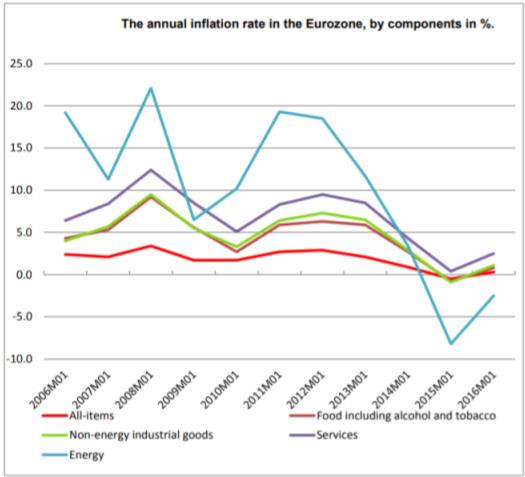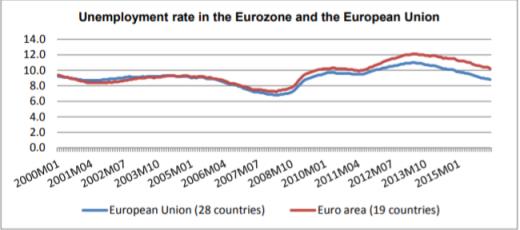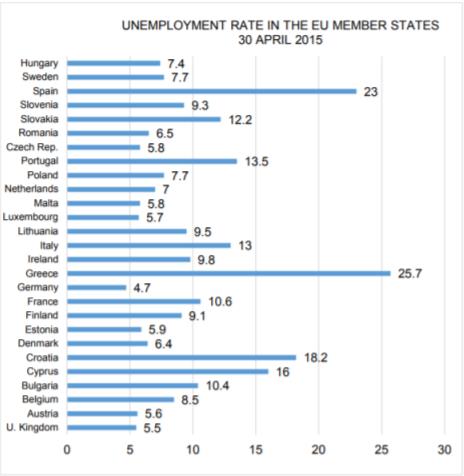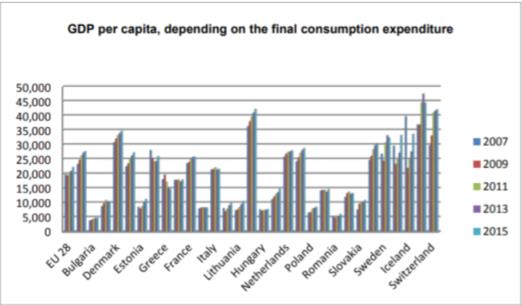Abstract
In the last decade, approaches related to integration areas and the effects resulting from the accession of the states to these areas have grown explosively, in both international and domestic literature. This situation occurred while increasing interdependence and economic flows between the economies of world states and of course the European economies. Efficiency and economic performance are important issues of current policies, their main objective being the stability of the target environment. In Europe, economic stability, economic growth and European integration are considered essential to adapting to current macroeconomic changes. Within this paper, based on reviewing literature on the approached subject, regional integration phenomenon is analysed in connection to the globalization process. In this regard, regional policy strategies promoted at EU level are examined in relation to the economic dynamics of EU states, in terms of performance and standard of living. One aspect that individualizes this paper is the analysis of integration on a regional and global level based on personal research of international documents. The study is based on the data provided by European and national statistics institutions.
Keywords: Economic growthintegrationglobalizationeconomic indicatorperformance
Introduction
International recognition and global supremacy undoubtedly represent priorities of world states. It is
well known that the European Union was created also to counterbalance the rising power of the United
States. Before the First World War and, especially after the Second, European integration and its
implications determined increasing debate on this matter.
At present, due to a multitude of many-sided problems occurred on the stage of international
economic relations, a wide convergence of views has taken shape in appreciating that the world has
changed profoundly and undergoing major political and economic transition.
During the last period, the efforts to forecast, cipher out, respectively, solve possible evolutions of
the world economy in terms of globalization, have taken the shape of economic development scenarios.
Thus, it can be reckoned that the scenario of economic development is a methodology to study the
economic phenomena and processes through explorative modelling of the development process,
associated with the role of subjective factors of the policies and decisions made by the subject of
international relations on the international economy evolution.
Consequently, globalization means giving up territorial limits, unlimited ascent of technology,
unconfined movement of information, economy uniformity, free movement of capital, goods, services
and people, and not least political alignment in the perspective of global governance.
Although regionalization and globalization are apparently two totally opposite phenomena, in fact
they are complementary processes that influence each other. The regionalization phenomenon marks
out the possibility to view more states within a geographical area approaching from the economic
and/or politic point of view. This phenomenon gained weight by gradual adaptation and multiplication
of regional agreements, first commercial and then otherwise, a phenomenon that contributes directly to
the globalization process.
In our opinion, the regional economic integration represents a key factor in the process of
globalization thus building the adequate institutional and political framework for the liberalization of
world economy. The state can recognize a regional identity - the region being perceived as a territory
deemed uniform by the state - and can take the necessary measures so as the regions to participate in
managing their own affairs. Regionalization can occur both nationally and internationally, the starting
point of regionalization being actually emphasized by regional imbalances, or by their awareness. This
awareness is followed by the intervention of national government structures or supranational entities
with a purpose to decentralize at a regional level the previously central level activities or competences.
The concept of regional integration has become increasingly employed by economists, politicians
and business people, especially because of the methods for global governance, governance that should
be able to better understand and solve problems occurring worldwide. I do not believe there is anyone
to challenge the need to review the current system of global governance (a system inherited after World
War II) both concerning its objectives and, particularly, regarding its implementation. The evolution of
international economy, globalization of exchanges and capital movements will have to directly take
into account the diversity of its actors, with different paces of development and living.
The Policy of Regional Integration at Global Level
Economic Growth and Regional Integration
It can be appreciated that both globalization and regionalization are key elements of the present
world economy, although, seldom, the relation between these concepts has been controversial. We say
this because there have always been voices or viewpoints that considered globalization and
regionalization as contrary processes. Not often regionalization was seen as a tool employed against
non-member countries by a group of states. Thus can be also construed the European Union’s case
where the "fortress Europe” expression appeared, used both by countries outside the European Union
and by Member States outside the Schengen area. On the other hand, these concepts are considered
compatible, the regional trading areas representing points that reflect, at a smaller scale, the
globalization phenomena and, last but not least, a way to contribute to creating a multilateral global
system.
In our views, globalization does not enjoy a precise definition, this word being actually a concept
that best characterizes the changes that take place every day in the contemporary world. These changes
occurring daily in the world economy mean for some people a better world without barriers, while for
others, they are seen as a threat. Thus, there is a possibility that globalization will become a cliché, a
wide idea referring to everything that happens around us and we cannot explain very well as the
problems encountered by the global economy and contemporary society. Regionalization can be
defined as a process of integration at regional level, or the representation of a conclusion of preferential
trade arrangements among a certain number of countries, some authors considering that regionalization
is the process that joins together states or regions based on their geographical closeness, due to the
advantages of economies in terms of transport and cost of information or due to problems related to
security or environment.
In order to better understand the process of global integration, it should be mentioned that the
concept of integration is etymologically derived from the Latin words integro (integration) integrato-
integrationis used with the meaning to renew, to restore, to replenish, to complement. In other words it
is about setting in a single place multiple parts of a whole, thus the constituent elements becoming
integral parts. The word integration is for the first time defined in the first edition of The Oxford
English Dictionary as combining parts of a whole. According to Macmillan English Dictionary,
integration can have three meanings: the process of becoming a full member of a group or society and
being completely involved in their activities; the process that enables people, regardless of race to use a
place, institution or organization; and the process of combining with other elements in a larger unity or
a unique system. Economic integration can be defined both as a process and as a state of affairs which
is reached through a series of changes. As a process, integration is the situation in which the national
components of a larger economy are not separated by economic borders, but work together as an entity
(Machlup, 1939: 11). The economic integration is all about building certain broader and broader
economic groups that would enable: enlarging the framework of labour division and specialization at
local, sector, branch, national, regional or global levels and increasing the productivity; freedom and
mobility for factors of production, goods and services; differential or discriminatory commercial
treatment in regard to the origin or destination of goods, services and factors of production. As a
consequence it can be estimated that globalization represents giving up territorial limits, unlimited
access to information and technology, economy uniformity, free movement of capital, goods, services
and people, and, last but not least a political alignment in perspective of a global governance. At
present, an analysis of the conceptual framework of globalization is the object of some ample concerns
within the United Nations through its bodies UNDP (United Nations Human Development
Programme), UNCTAD (United Nations Conference on Trade and Development), UNESCO (United
Nations Educational, Scientific and Cultural Organization). Following the Millennium Summit in 2000,
the 191 member states of UN unanimously adopted (El-Agraa, 1994: 1) eight Development Goals of
the Millennium:
These eight goals have dictated the main directions of global efforts, proposing to reduce the most
significant problems we face in contemporary society by 2015. Between 2000 and 2015 important
progresses were made in achieving the proposed indicators (Molle, 1990: 10), which allowed a
significant improvement in the living conditions for many people in the poorest countries.
Models of Economic Growth and their Relationship with the Economic Integration Process
The models of economic growth are varied and have developed over time, according to the
evolution of economic reality and tools of economic analysis. These models, namely theories of
economic growth, limn the manner in which a present activity is reflected in the future and can identify
the key points that ensure a real economic growth. The classical economic growth models of Adam
Smith (2011), Thomas Malthus (1992) and David Ricardo (1959: 334) described a way of economic
development specific to the times they lived. Malthus considered that the population will continue to
grow as long as remunerations are above subsistence level. The Malthusian balance is reached when
the remuneration drops at the level of subsistence and the economy is maintained in a permanent state
of balance. Thus, in Malthus's view, if the lack of prospects for production increases per capita, most of
the population will be condemned to live at subsistence level.
David Ricardo believed that "a country will specialize in the production of that item that brings an
absolute advantage in relation to any other item that can be produced from the given resource". Thus, it
has been attempted to be proven through the model of comparative advantage that international trade
exchanges ensure mutual advantage. So, if a country that participated in international trade had
comparative advantage, it would certainly stand to gain, without the need of absolute advantage. This
explains the fact that there is always comparative advantage when the labour factor varies from one
state to another, causing different internal costs. At the end of the Second World War, following the
emergence of new technologies and industries, a new approach to economic growth had taken shape, to
which contributed, among others R. Harrod (Keynes, 1936), R. Solow (1956), P. Samuelson
(Samuelson & Nordhaus, 2004), J. Hicks (1937), F. Perroux (1948), R. Dornbusch (1976). Capital
accumulation formed the core of modern economic analysis in that period. In the mid-80s a new theory
of economic growth appeared, promoted by Paul Romer (1986) and Robert Lucas (1988), through
which the accumulation of capital was in a permanent interrelation with knowledge accumulation. Of
course, the new theory of economic growth focuses particularly on the technological progress believed
to be product of the economic activity, contrary to previous theories which considered that technology
is produced by forces outside the market. This is how modern theories of economic growth lay
emphasis on the unlimited potential of technological development generated by economic activity.
All these theories of economic growth, classical, Keynesian and post-Keynesian, neoclassical, up to
modern and contemporary theories, have contributed step by step to the economic development and
growth of national economies as a whole and, because of this, the development of global economy, for
today to develop theories of regional economic growth at global level.
Generally, the characteristics of economic growth are described by:
- macroeconomic models, that cover the entire national economic area, this class of models being
distinguished by the fact that it operates with macroeconomic indicators of effort and results and,
last but not least, outlines the overall structure and functionality of the economic system;
- models of economic dynamics, which reflect the change over time in values of various parameters
specific to economic growth, as well as the interdependencies among them. Very important for the
dynamic nature of the economic growth models is the concept of economic growth trajectory,
referring to a series of states reached effectively or different forecasts in carrying out the growth
process for a given time horizon.
In the end, we can appreciate that these models enable the construction and analysis of economic
growth trajectories in relation to various assumptions or options.
Policies of Regional Integration
The regional economic growth may be influenced by certain economic, social, political and other
nature factors that, within a region, are heavily influenced by the government manner of states in the
region. In addition to the relations among states, the conclusion of some treaties tied to ensure a priority
of economic development in the region is also essential to the internal activity of economic and social
development of states in the area taken into account. In this context we consider there are three main
objectives which pragmatically contribute to a successful regional integration:
- economic development: free movement of goods, services, capital and people enables an overall
development by stimulating investment in various fields of activity and in larger spaces. In this context,
by intensifying regional and extra-regional competition, and, why not, through an adequate
protectionism an optimum integration into the system of global trading may be ensured, thus regional
integration becoming a vector for economic growth and poverty reduction.
- political stability: is a basic condition for real economic development, in the sense that all regional
organizations play an increasingly important part in the annihilation of conflicts that may occur inside
countries and among them.
A very plausible example of strategic policy of regional integration is the Europe 2020 Strategy,
which was adopted by the European Council on 17 June 2010. The European Union's Agenda places
the stress on smart, sustainable and favourable to inclusion growth, as a means of overcoming the
structural weaknesses of the European economy, in order to improve Europe’s competitiveness and
productivity and, not least, to support a sustainable social market economy. The main objectives of the
strategy take into account that 75% of the population aged 20 to 64 years should be employed and 3%
of the EU’s GDP should be spent on research and development. The main goals of the Europe 2020
Strategy can be very well noticed through nine indicators in Table No. 1, below.
Economic Situation in the European Union
2.2.1.1. Inflation and Unemployment
In Figure
the EU. In total components, services and food along with tobacco and alcohol seem to have the
highest annual increase, 0.9% respectively, while the price of energy being in a permanent decrease
from -5.8% to -6% in March 2015.


However, data regarding the unemployment are not encouraging, in the Eurozone unemployment
rate being maintained steady at 11.3% in March 2015, thus exceeding the forecasts, especially due to
the negative evolution of Italy (13%), an evolution which is somehow lower than the 11.7% in March
2014. In terms of value, 23.75 million people in the EU 28 were unemployed in March 2015, out of
which 18.1 in the Eurozone. At the EU 28 level, unemployment rate was 9.8% in March 2015,
dropping from 10.4% in March 2014 (see Figure No. 2).
At country level, the lowest unemployment rate was recorded in Germany (4.7%), and the highest
was recorded in Greece (25.7%) in January 2015 and Spain (23%). Compared to last year,
unemployment rate dropped in 22 EU member countries and increased in five, while in Austria
stagnated. The highest decreases were recorded by Spain (from 25.1% to 23%), Ireland (from 12% to
9.8%) and Poland (from 9.6% to 7.7%), while increases were recorded in Croatia (from 17.3% to
18.2%), Finland (from 8.4% to 9.1%), Italy (from 12.4% to 13%) France (from 10.1% to 10.6%) and
Belgium (from 8.4% to 8.5%), a situation that can be clearly noticed in Figure
example, the unemployment rate dropped in the same period, respectively March 2014 - March 2015
from 6.6% to 5.5%. The situation of young people (18-25 years) in the European Union continues to be
questionable, those being a vulnerable category on the labour market. While in the EU 28, this
indicator shows 20.9% in March 2015, respectively 4.8 million people, Spain and Greece are in their
fourth consecutive year of recording unemployment rates above 50% among young people.

Major problems of the young are also seen in Croatia (45.5%), Italy (43.1%) or Portugal (33.8%).
Romania had a youth unemployment rate of 23.6% in December 2014, above the EU 28 average. Not
by mistake a change in the young people’s perception is also found compared to the economic and
social model of the EU, especially in countries where unemployment rate is higher, fact that can be
easily seen from the political orientation and their involvement in various leftist organizations and
social movements, such as Podemos in Spain and Syriza in Greece.
The persistence of distrustfulness in the ability of market economy to straighten and create new jobs,
as well as the lack of confidence in the national and European authorities is mainly mirrored by the
political leadership of these countries, with unpredictable effects on the EU’s future.
2.2.1.2. Evolution of Gross Domestic Product
Gross domestic product summarises the economic position of a country or region. For an easier
comparison, data expressed in various currencies can be converted into a common currency - for
example, they can be converted into euro or dollars. Nevertheless, the exchange rates do not reflect all
differences among price levels between one country and another. In order to make up for it, the GDP
can be converted using conversion factors known as purchasing power parities.

The use of purchasing power standard instead of converting currency based on euro tends to have
the effect of levelling, since the regions with very high GDP per capita in euro tend also to have
relatively high levels of prices (for example, see Figure
London is generally higher than the cost of living in rural areas from Bulgaria or Poland) .The highest
level of GDP per capita was recorded in Inner London. In 2013, approximately 15% of the 250 NUTS
2 regions for which data is available reported that their GDP per capita was at least 25% higher than the
average at the EU-28 level; these are shown with the darkest shade of green. Many of them are capital
regions or areas in the neighbourhood of capital regions, while most other regions are grouped together
in the centre of the map, covering the South of Germany, West of Austria, North of Italy as well as
Switzerland.
There are three regions where GDP per capita in 2013 was more than double the average in the EU-
28, namely: Inner London, Luxembourg (unique region at this level of analysis) and Brussels-Capital
region. Regional disparities can be caused by a number of factors, among which can be distinguished:
the geographical distance or reduced number of population, social and economic changes or legacy of
the past economic systems. These inequalities may take the form of social privation, poor quality health
care or education and, of course, high levels of unemployment or inadequate infrastructure. In this
context, the EU regional policy intends to support the wider agenda of Europe 2020 strategy. It is
designed to promote solidarity and cohesion, so that each region to reach its full potential, by
increasing competitiveness and employment and by bringing the standards of living from poorer
regions up to EU average as soon as possible.
Conclusions
It should be underlined that the functioning of the European Union depends first of all on the unity
of component subsystems which represents the first condition to understand the need for coherence at
every level, including the policies, strategies, plans and programs for development. Within this system,
formulating regional policy at EU level has an important place, which continues at national and
regional level, with the stage of programming strategies, plans and programs so as to implement this
policy that, in time, will have macroeconomic effects on a medium and long term. In the European
Union case, the importance of this policy is special since it directly influences the orientation of
Community and national financial resources to those projects supporting the overall development of the
Union as a whole.
Together with liberalization of markets following the 80s, an increased weight of emerging markets
within the globalization process may be noticed, weight displayed through:
Thus, an increase in the competitiveness degree on foreign markets due to joint efforts mobilization
can be clearly seen. On the one hand, it should be kept in mind that both socio-economic phenomena,
namely globalization and regionalization, are nothing but some processes that unfold in time,
throughout many years. On the other hand it should be mentioned that globalization focuses on the
principles of economic liberalism, leading to the homogenization of likings, while regionalization is a
combination of protectionism and liberalism. In terms of barriers and their freedoms, there is no doubt
that both have advantages and disadvantages, but at the same time it can be estimated that the two
processes are in a relation of complementarity. In the last decades there has been a reduction in the
imbalances and inequities among more prosperous areas and those less developed of the EU. This
process has been generated in part by the existing trends on long term in the advanced market
economies, by the efforts of national policies regional towards equalizing, by other policies and rules of
the European Union laid down in favour of encouraging trade and mobility, as well as by the
Community interventions through the regional policy.
References
- Machlup, F. (1939). The Theory of Foreign Exchange. Economica Publishing.
- El-Agraa, A. M. (1994). The Economics of the European Community. 4th ed. Harvester: Wheatsheaf.
- Dumitru M., et al. (2002). European Union Economy. Bucharest: Luceafarul Publishing House.
- Molle, W. (1990). The Economics of European Integration. Dartmout: ed. Aldersshot Dartmouth.
- Smith, A. (2011). Wealth of Nations. Bucharest: Public Publishing House.
- Malthus, T. (1992). Essay on the Principle of Population. Bucharest: Scientific Publishing House.
- Ricardo, D. (1959). Selected Works. Volumul 1: On the Principles of Political Economy and Taxation. Bucharest: Academiei Publishing House.
- Keynes, J. M. (1936). General Theory of Employment, Interest and Money. Cambridge: Palgrave MacMillan Cambridge University Press.
- Solow, M. R. (1956). A Contribution to the Theory of Economic Growth. The Quarterly Journal of Economics, Volume 70, 65-94.
- Samuelson, P., Nordhaus, W. D. (2004). Economics: An Introductory Analysis. Irwin/McGraw-Hill Publishing House: 2004
- Hicks, J. R. (1937). Econometrica: Mr. Keynes and the Classics - A Suggested Interpretation.
- Perroux, F. (1948). Économie appliquée: Esquisse d’une théorie de l’économie dominante.
- Dornbusch, R. (1976). Expectations and Exchange Rate Dynamics. The Journal of Political Economy, 84(6): 1161-1176.
- Romer, P. (1986). Increasing Returns and Long-ran Growth. Journal of Political Economy, Volume 94(5): 1002-1037.
- Lucas, E. R. (1988). On the Mechanics of Economic Development. Journal of Monetary Economics, 22: 3-42.
- European Union's Agenda: Europe 2020 Strategy available at: http://ec.europa.eu/eurostat/web/europe-2020indicators/europe-2020-strategy
Copyright information

This work is licensed under a Creative Commons Attribution-NonCommercial-NoDerivatives 4.0 International License.
About this article
Publication Date
04 October 2016
Article Doi
eBook ISBN
978-1-80296-014-3
Publisher
Future Academy
Volume
15
Print ISBN (optional)
-
Edition Number
1st Edition
Pages
1-1115
Subjects
Communication, communication studies, social interaction, moral purpose of education, social purpose of education
Cite this article as:
Dima, ., Neculiţă, M., & Şarpe, D. A. (2016). Regional Integration and the Impact on Economic Growth and Development. In A. Sandu, T. Ciulei, & A. Frunza (Eds.), Logos Universality Mentality Education Novelty, vol 15. European Proceedings of Social and Behavioural Sciences (pp. 275-286). Future Academy. https://doi.org/10.15405/epsbs.2016.09.36

